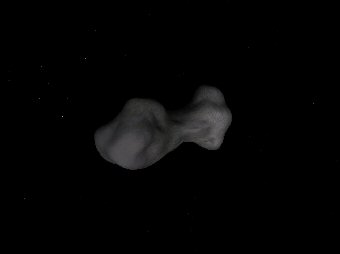BY LETTER
Solar System in 560 AT
History > 0030 to 0900 AT: Solsys Era
History > 0030 to 0900 AT: Solsys Era > 530 to 900 AT: The Sundering
Galactography > Other Major Polities, Empires, and Meta-Empires > Solsys Organization
History > 0030 to 0900 AT: Solsys Era > 530 to 900 AT: The Sundering
Galactography > Other Major Polities, Empires, and Meta-Empires > Solsys Organization
A brief account of the state of Solsys in the period before the Technocalypse | |
Image from Steve Bowers | |
| Sol | |
The star Sol is orbited by various solar weather and scientific satellites. There is talk of one day building a network of power stations in close solar orbit, but the first attempt at this faced so many technical and financial challenges that it failed spectacularly, leaving two abandoned stations operating at 1/5 the distance of Mercury, a host of mothballed equipment in receivership, and a swarm of lawsuits that have been running for over a century.
A half-dozen Vulcanoid asteroids have been discovered in extreme close solar orbit. Automated probes have performed fly-by missions of several of these, but no crewed missions or economic development have taken place.
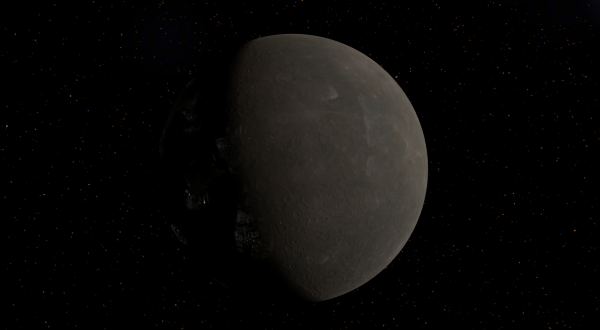 Image from The Astronomer | |
| Mercury in 565 AT | |
Mercury
Population: 150,000 sophonts.Mercury is home to a number of major automated metal mining operations. Some sub-surface habitats and various cultures, including the Joh-Lau Superior culture. Large Neumann populations are operating at multiple locations on the surface.
Magnetic launchers used to boost payloads into orbit where they deploy solar sails made from local materials to transport themselves to destinations all over the solar system. Subsurface eDen complex operating as experimental mechosystem using self-replicating machines of various sorts. Three extra large magnetic launch complexes (each over 300 km long) are used to boost bionts and less sturdy equipment into space when required.
Mercury Environs
Population: 10,000 sophonts.Circum-Sol amat farms operating just outside Mercury orbit. 3 grams per year production. Exa Energy operates many amat farms in competition with the consortia of the Look Outwards Combine, Jerusalem Macrotech, and General Dynamics Corporation.
Amat payloads launched from the farms by magnetic launcher, where they deploy magnetic sails and are then boosted up to speed using particle beams fed by the 'waste' H2 created by the amat production process. The payload containment and magsail hardware are created using raw materials mined from the asteroid 'anchors' used to prevent the solar power arrays from drifting away from the pressure of light striking them. Additional station-keeping functionality is provided by varying the reflectivity of the solar power arrays, turning them into partial statites, and by the reaction pressure of the payload launch particle beams.
Venus |
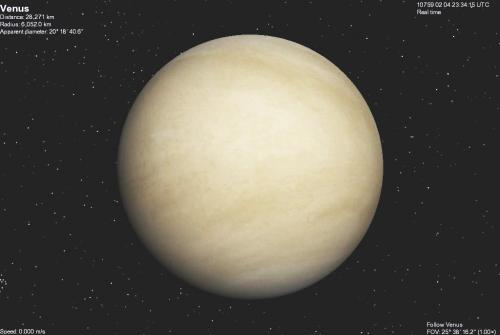 Image from Steve Bowers |
Venus
Population: 25,000,000 sophonts, about five million living on floating habs riding in the upper atmosphere, the rest living in orbit.Several thousand small bubble habitats of various sizes operate in the upper atmosphere of Venus, mostly inhabited by various tweak clades.
Half a dozen rotovator type skyhooks orbit the planet and dip into the atmosphere to extract CO2 for use in local industry and export to the Venus L1 and L2 Swarms or elsewhere in the Solar System. Over 50 habitats and industrial installations orbit the planet, including a 5 km long O'Neill-type cylinder operated by the Venus Terraformation Project. A network of rotovator cables is used to catch payloads from the extraction skyhooks and orbital industrial centers and launch them toward Venus L1 or beyond.
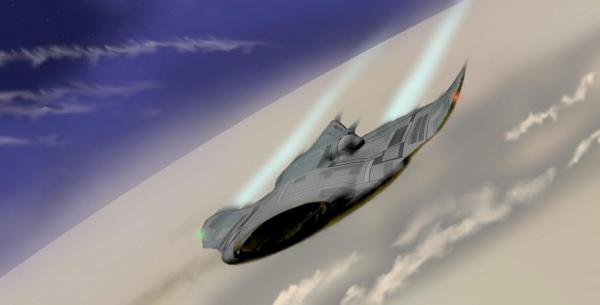 Image from Steve Bowers | |
| A SkyScoop mining ship skims the cloud-tops of Venus to collect CO2 and other gases | |
Important mining consortia from this period include IshtarCorp and SkyScoop. Customers of the Venusian industrial powerhouse include Luna, the Cislunar orbitals, and other carbon poor locations. Half a dozen comets have been parked in Venusian orbit, primarily to provide volatiles, but there is some talk of eventually using at least some to test out early terraforming techniques involving cometary impact. The inhabitants of the downplanet bubblehabs view these ideas with distaste to say the least.
Venus environs: (Population - approx. 600,000 sophonts)
Venus L1 point: - Large industrial center dedicated to construction of the power swarm being built there (the plan is to operate beamed-power transports around the Inner System as well as provide energy for other major operations). Mostly automated; only about 500 sophonts make their homes at the L1 point, generally on a temporary basis.
Venus L2 point: Major industrial and manufacturing center using CO2 shipped from Venus and mining of several asteroids maneuvered into the L2 point. Some 20 major and minor habitats holding some 600,000 beings occupy the L2 swarm and oversee several hundred manufacturing, packaging, and shipping installations of varying sizes. Several comets have been maneuvered into the L2 point and protected by sunshades to provide water and other volatiles. High-tech finished goods and bulk lots of advanced materials are shipped all over the solar system, including to construction points for interstellar vessels and the nearly completed interstellar beamrider system.
Venus L3 point: No significant development at this time.
Venus L4 and L5: Independent power swarms and habitat clusters, each supporting different objectives. Venus L4 is the base of operations of the Beamrider project operated by the Cislunar Alliance while Venus L5 is the center of the Starwisp project which uses high powered masers/lasers to boost uncrewed probes to several local stars.
L4 is home to 5 smaller habitats and 10,000 people while L5 is home to 3 habs and 8000 people.
The Earth-Moon Volume |
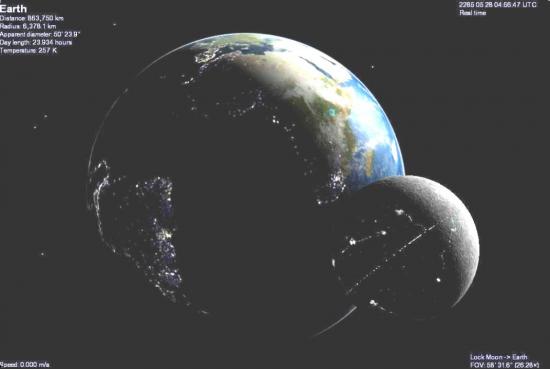 Image from Steve Bowers |
Earth
Population - 22 billion sophonts, mostly baselines, near-baselines, various tweak, splice, and provolve clades, some AIs and vecs, and a very few uploads.Planetary Surface
Habitation: The majority of the planetary population lives in arcology cities, although significant numbers (mostly the wealthy and well-to-do) continue to live in small towns and cities of more traditional design. Floating arcology cities on the ocean surface and undersea habitats provide living area for humans (baseline and near-baselines both) as well as mer-people and provolved cetaceans.Environment: By the standards of earlier ages, the ecosystem has been restored to an amazing degree. Wilderness covers much of the planet, and many extinct or near-extinct species have been restored via lazurogenics and advanced biotech. However, much of this is only surface appearance. Most of the planetary ecosystem is entirely a made thing, with much less complexity than what had naturally existed before the development of prior centuries destroyed or damaged it. The ecosystem as a whole is managed as a planetary resource, with tight controls in place to both maintain and exploit it in the most efficient manner.
Agriculture
Advances in biotech, greenhouse agriculture, and vertical farming have reduced the amount of land given over to farming to only 1/3 of that seen in the Information Age. Hunger and the various negative side effects of hunger are effectively unknown on Earth at this time. Of the land freed up from agriculture, perhaps half has been given over to wilderness, largely as part of efforts to restore ecosystems and sequester CO2 released in earlier eras. The remaining land is given over to nanofacture and biofacture "farms" that use gengineered plants, plant-like nanofactories, or fabbing pools to produce consumer goods, advanced medications, and various components and devices. Significant portions of the ocean surface of the planet are given over to ocean-thermal power systems whose operations are used to support intensive aquaculture for both food and biotech/nanotech based industrial operations.Energy and Resource Production
Planetary energy requirements are provided by a mix of fusion reactors, space-based solar power, ocean thermal energy systems, and various renewable technologies including wind, geothermal, ground based solar, and biotechnology based systems. Although primary sources still mainly consist of large scale systems feeding into the planetary grid, privately operated solar and wind power systems are common and cheaply produced via nanotech based manufacture. In particular, the Backyarder and related movements make extensive use of this technology.Resource extraction operations take place across the planet. A primary resource is the CO2 in the atmosphere, much of it produced during earlier ages. Bio and nanotech systems are used to extract metals and other useful elements from seawater, from ancient garbage dumps, and areas that previous ages could not usefully use. Robotics and advanced technology allow both mining and petro-chemical extraction wherever useful sources can be found, at virtually any depth. The hydrocarbons extracted are used in nanofacture and biotechnology processes.
Massive recycling means that actual 'new' resource extraction operations only account for 10% of all resources used, mostly for shipment offworld or the growing population.
Planetary Transport
Vac-Trains connect most major cities on the major land masses and even pass beneath the surface of the ocean for short distances in some cases. Sub-sonic, super-sonic and sub-orbital passenger craft (built via nanotech) provide the bulk of long-range transport not handled by vac-trains. Automated piloting and nanotech have allowed the creation of aircars and other personalized air-transports for cheap, often rental, use by private individuals.Automated driving systems, advanced materials, and fuel-cell technology have meant that automobiles of various sorts still provide the bulk of all ground transport on the planet. However, almost no one actually drives any longer since, by law, most humans are not allowed to operate motor vehicles.
Terran Orbital Space
500 million sophonts live in habitats spread across Earth orbit from LEO bubble habs to geosynch and high orbital spin tori and O'Neill cylinders.Six beanstalks link the planet to geosynchronous orbit (touching down in Indonesia, Brazil, Gabon, the highlands of E. Africa, the Indian ocean along the equator, and Ecuador), along with hundreds of spaceports serving LEO and middle level orbits. The Clarke band in geosynchronous orbit is so heavily developed that from Earth's surface it forms a misty belt across the sky at night. The largest elements are partly visible in the day time. The band is colloquially referred to as the Halo by many people. The rest of Earth orbit is also heavily developed from LEO out to beyond geosynch. Habitats, industrial modules, and laboratory spaces operate across multiple levels, although care must be taken to avoid the planetary beanstalks.
100 solar power satellites operate at GEO, each producing some 50GW of power that is beamed down to the planetary surface.
Luna
Population: 230 million sophonts live on and beneath the Lunar surface, including baselines, near-baselines, provolves, early Superiors, AIs, vecs, and a few uploads.Habitation: The majority of the Lunar population lives in subsurface arcologies, although large artificial caverns contain self-sustaining biospheres. Some biospheres have also been constructed on the surface in some of the smaller craters and on the lunar plains, primarily as experiments or entertainment attractions. Several dozen major population centers dot the surface along with hundreds of smaller communities and even family "homesteads".
Environment: Several large telescopic arrays (optical and radio) dot Lunar Farside. The Equatorial Mass Driver bisects the Moon. There is talk of building an Equatorial Particle Accelerator as well, although this remains speculative.
Agriculture: Lunar food production takes place using a combination of subsurface agricultural complexes and food synthesis based on algae and bionanotech. Most agriculture complexes are placed near the surface and use fiber-optic arrays to "pipe" sunlight down into the complex during the lunar day. During the long lunar night, artificial lights powered by fusion reactors or solar arrays located on the Dayside are used. A few luxury foodstuffs are produced in habitats operating in lunar orbit. These "foodsats" are able to precisely control all aspects of their internal environment, including air pressure and spin-generated gravity, to produce various fruits, vegetables, and meats that are supposedly far superior to items produced under less controlled conditions.
Energy and Resource Production: Primary lunar energy supplies come from surface based solar arrays (only functional for half of each lunar day), with secondary power coming from fusion reactors. Superconducting power grids extend across the surface, allowing power generated on the Dayside to be sent all the way to the Nightside on an ongoing basis. Various robotic and Neumann devices roam the Lunar surface extracting metals, helium-3, and oxygen from the soil. Mined and extracted materials are used for local construction and manufacturing and are also exported off-world. Three comets have been soft-landed on the lunar surface to provide volatile reservoirs and are mined by consortia of the various lunar communities. An additional half dozen comets are parked in lunar orbit for future use, either for orbital construction or to replenish surface supplies.
Planetary Transport: Maglev trains link the major population centers of Luna, mostly subsurface to protect against micro-meteorites. A network of lunar roads, built from fused lunar rock, provide short range personal and long range cargo transport around the moon. Personal ground transports are usually pressurized, although some simply contain air supplies that can be linked into the passengers' spacesuits. Cargo transports on the moon may or may not be pressurized depending on their cargos.
Lunar Orbital Space: Population - 5 million sophonts live in habitats in lunar orbit.
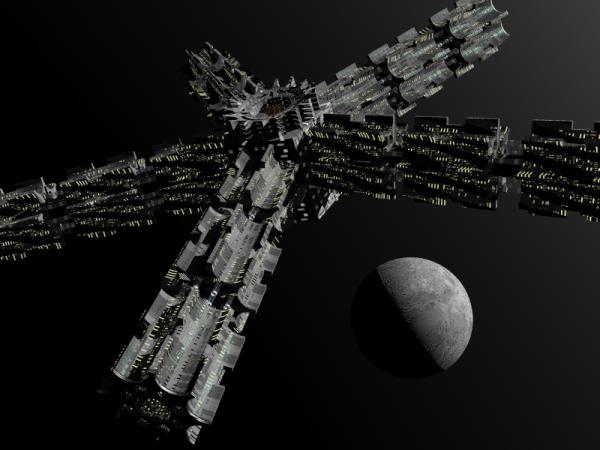 Image from Anders Sandberg | |
| Asherah, a habitat in high lunar orbit | |
Earth-Moon Lagrange Points
L1: Mostly occupied by automated solar power swarms used to beam energy to craft traveling between Earth, Luna, and the L4 and L5 points. Although only partially stable, the solar arrays are able to largely hold station via the use of smart matter materials that alter their reflectivity as required. Small amounts of volatiles provided by ice chunks shipped from the outer system or mined from intercepted comets make up the difference. Occasional visitors to service the power swarms or deliver volatiles, but no permanent inhabitants.L2: Occupied by various astronomical and communication devices, otherwise uninhabited in any permanent or long term manner.
L3: Not used for anything, no permanent inhabitants.
L4: Population - 50 million, all living in several dozen habitats of various sizes and designs. Primary Industries - Asteroid and comet mining, free-fall manufacturing, including spacecraft production, free-fall and low gravity sports and recreation. Several interstellar probes and starships have been built and launched from L4.
L5: Population - 100 million, spread across over a hundred habitats of various sizes and designs. Primary Industries - Asteroid and comet mining, free-fall/micro-gravity manufacturing, nanotech and biotech research and development, computronium and virch creation, gengineering. Several highly regarded universities and research labs operate in L5 and the volume is one of the technological powerhouses of the solar system. The Turing Prime project has just completed construction of the largest experimental computronium node/virtual space habitat yet created.
Martian Volume |
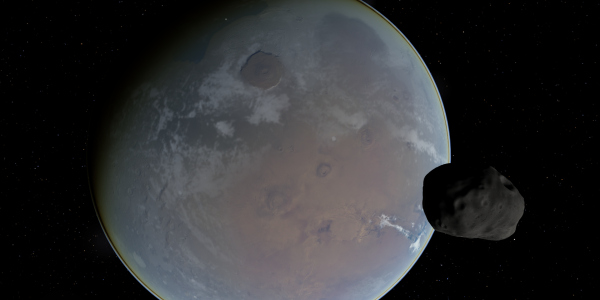 Image from The Astronomer and Dangerous Safety |
Mars
Population - 2.5 billion sophonts, mostly tweaks and cyborgs living in the great city complexes. A strict planetary immigration policy arising out of a strong nativist movement means that the vast majority of population growth arises from local birthrates, which are quite high.Planetary Surface
Habitation: Huge cityplexes, made up of a mix of arcology structures and domed communities house the majority of the Martian population. Other, smaller communities operate as subsurface tunnel complexes, roofed over canyons, or simple collections of linked habitat modules in the traditional style.Environment: Atmospheric pressure is at 250 millibars. Nearly 2/3 of the planet is covered in a gengineered ecosystem created over the centuries since terraforming began. Mostly plant based, the dominant organisms are mosses, lichens, algae, and fungi spread between scattered clumps of brush and smaller tree species, both evolved and gengineered. There are also a number of large, low elevation oases of high pressure and more complex organisms such as flowering plants, gengineered insects, and small to medium animals such as mice, voles, and rabbits and various small to medium sized predators to hunt them. Liquid water oceans cover a portion of the surface and a complex, although still mostly microscopic, aquatic ecosystem is up and running. The first juvenile forests are growing in the largest high-pressure zones, and some lakes support complex ecosystems up to and including fish.
Birds are fairly common, mostly ground-dwelling species such as kiwi, quail, emu, and wild turkey although long range migratory species able to operate at high altitudes, such as the Canada goose, can also be readily found. The smaller soaring species are still comparatively rare, although their numbers are growing rapidly, particularly those species that operate around the planetary oceans or the great canyons.
Agriculture and Aquaculture: Farming operations are similar to those found on Earth, with large greenhouses and vertical growing complexes producing the bulk of the planet's food supply. However, a significant percentage of Martian agricultural output is found in the form of old-style field based farming, using gengineered plants to both produce food (including various species such as meatshrooms and deli-plants which have largely displaced the raising of large mammals for food across the solar system) and increase the density of the planetary atmosphere. The first Martian vineyards have already produced the first Martian wines, although these are generally agreed (even by most Martians) to not yet be up to the standards of vintages produced on Earth.
Aquaculture is actively pursued in several of the largest Martian lakes and the oceans. Mollusks, fish, and seaweeds, both evolved and gengineered, produce both food and a wide range of bioproducts of various sorts.
Virtually all farming is automated with AIs overseeing large numbers of bots ranging from synsects up to large harvester units the size of buildings.
Energy and Resource Production: Planetary energy requirements are provided by a mix of fusion reactors, space-based solar power, and various renewable technologies including wind, ground based solar, and biotechnology based systems. Primary sources consist of large scale systems feeding into the planetary grid and major population centers. However, individually operated solar and wind power systems are extremely common and cheaply produced via nanotech based manufacture. The Martian planetary energy grid is much less extensive than that of Earth, and mainly links the largest population centers. Smaller communities and individual homesteads are virtually all independently powered using local sources constructed via nanofabs.
Primary resource extraction operations take place in orbit using asteroids and comets placed there for the purpose. Resource extraction is massively automated with small crews of sophont overseers each operating dozens of robot mining, processing, and shipping operations. Secondary resource extraction operations take place on the planet; usually as a side operation around some of the terraforming efforts (the exception to this is the uranium mining operations at Elysium which supply both Martian fissionable needs and a profitable export business to the Belt and Outer System). Recycling technology is even more advanced than on Earth and means that actual 'new' resource extraction operations only account for 5% of all resources used, mostly in response to the growing population.
As part of the terraforming process, Martians have experimented extensively with various weather and climate control technologies, most recently early attempts to create weather modification swarms based on tiny balloons operating in the upper atmosphere and acting to focus or diffuse sunlight. Problems of command and control of such widely dispersed and complex systems make them highly speculative at best, but efforts continue.
Planetary Transport: Vac-Trains connect the major cities on the major land masses and even pass beneath the surface of the new oceans for short distances in some cases. Sub-sonic, super-sonic and sub-orbital passenger craft (built via nanotech) provide the bulk of long-range transport not handled by vac-trains. Automated piloting and nanotech have allowed the creation of personalized air-transports for cheap, often rental, use by private individuals; although the more widely dispersed population (in comparison to Earth) means that more people own their own transports.
Ground transport is handled via automated vehicles similar in many respects to those found on Earth, although many use pressurized compartments for the benefit of passengers who are not tweaked to handle the local environment.
Ground-to-orbit transport is handled by a space elevator (the Up-N-Out) and over a hundred spaceports using laser-launch and fusion drive shuttles.
Martian Orbital Space
Population: 330 million sophonts live in habitats spread across Mars orbit. Martian orbital habitats tend to be larger and more numerous than their Terran equivalents, with smaller populations per habitat and more wilderness or open spaces. The sum total of Martian habitats and industrial complexes forms a belt around the planet generally referred to as the Torus, in competition with Earth's Halo. Unlike the habitats of Earth, the entire Torus is ruled as a whole by the Martian government and maintains cordial but sometimes cool relations with the Cislunar Alliance, which it largely considers as little different from any other group of non-Martian "outlanders" to be viewed with mild condescension.Some three dozen asteroids and two dozen comets orbit the planet, hosting massive industrial operations that not only support the Martian population but supply finished goods all over the solar system. Martian-built spacecraft are generally considered the most advanced and reliable in the solar system (a product of the first colonists' experiences with the long journey-times to the Red Planet). Most use dense networks of sensors to detect any wear or damage and a system of robots, matter reservoirs, and a nanofab to repair and replace worn parts before they become a problem. Martian life-support systems are built around gengineered microorganisms designed for high radiation resistance, low mutation, and unmatched reliability. The most advanced Martian ships are reserved for the Martian Defense Forces. It is rumored that these ships take the technology of sensors, robots, and nanofabs to a whole new level, making each almost a living organism in its own right, with nanotech permeating nearly every aspect of the ship, up to and including the heavily cyborged crews.
Fully a third of all interplanetary spacecraft in the solar system in 560 AT are Martian-built or have been refit to Martian technology and standards.
25 solar power satellites operate at Martian synchronous orbit, each producing some 30GW of power, some of which is beamed down to the planetary surface, although most is sent to orbital industrial operations.
A number of soletta and statite solar mirrors operate around Mars, working to melt its icecaps and warm the planet. The L1 Magshield protects Mars from the effects of the solar wind and flares, but also operates as a major power source for Martian civilian spacecraft and major industrial or climate modification operations (when required). Several interstellar probes have also been launched using the energy of the magshield at various times.
Phobos
Two million sophonts live on and beneath the surface of Phobos, Mars' inner moon. Half of these are uploads or AIs living in the large computronium cores built within the moon. The embodied population lives in networks of tunnels and caverns carved into the moon, while the aioids and uploads live in virtual realities and interact with ril via advanced telepresence robots and 3D projection technology. Phobos hosts a major technical school and research complex specializing in virtual reality, a-life, and computronium development. A joint venture between the Martian Defense Forces and the Phobos research community has built a large (40km long) mass-driver complex through the center of the moon to launch probes and instrument packages into the Kuiper Belt and Oort Cloud (some parties accuse the project of being used to launch stealthed spy probes to various locations around the solar system). A major research project is attempting to create a simple but self-sustaining robotic ecology (eDen II) inside an asteroid in the Belt.Deimos
50,000 sophonts live in habitats on or beneath the surface of Deimos. The Deimos Orbital Shipyards produce craft that travel all over the solar system and are the source of the Mars Defense Force, whose main base occupies an asteroid orbiting on the opposite side of Mars from the moon, but at the same distance and inclination. While the original Shipyards used the materials of Deimos itself to build spacecraft, a number of secondary complexes have grown up in recent decades around smaller asteroids that have been positioned "in formation" with the main moon and are used for construction material instead of Deimos itself. Some people have suggested that Deimos should be used as an anchor for a Martian space elevator but this is generally rejected for reasons of economics, "planetary pride" (which sees space elevators as an "Earth invention"), and the desire to preserve Deimos in its "natural state".The Asteroid Belt
Over three hundred major habitats and mining operations are spread across the main asteroid belt along with nearly a thousand much smaller communities. Most of the mining operations are automated facilities using Neumann technology to process and/or move asteroids for eventual consumption by civilization. Major asteroids such as Ceres and Vesta are home to large population centers, (Ceres - 550,000, Vesta - 200,000) but numerous smaller colonies are scattered across the Belt. Most colonies oversee large swarms of Neumanns and bots which mine, move, and process asteroids into materials for the rest of the solar population, mostly in the Inner System, but also including a significant percentage for the Outer System worlds. Some Belt colonies are utopian experiments or labs researching cutting edge bio and nano technologies. Some are illicit banking, computronium, or data transmission centers, routing the money and bits of the grey economy.Asteroids within the Belt are moved by mass driver, light-sail/magsail systems, or gravity tugs. It can take decades for an asteroid to make the journey from the Belt to its destination. But numerous rocks are 'in the pipeline' at any given time, marked by beacons and overseen by AIs and automation. More often, asteroids are mined and processed by automated systems and the extracted and processed materials are launched to their destinations.
The starships that have been launched to date have all incorporated materials provided by the Belt.
The Ceres Shipyards produce 10% of all ships in use in the solar system. While not as advanced as ships produced at Mars, Ceres ships have a solid reputation for reliability and safety.
Total population of the Asteroid Belt is about 3 million sophonts.
Jupiter, Saturn, and the Outer System
The Jovian System
The Jovian System |
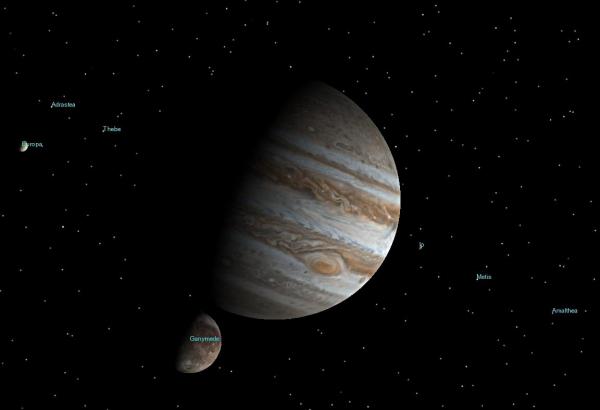 Image from Steve Bowers |
Jupiter
The Jovian atmosphere is host to some 100,000 floating bubble habitats, each home to around 2000 sophonts, almost entirely high-gravity tweaks or vecs. AIs and some uploads form a significant minority as well. Total planetary population is approximately 220 million sophonts.In addition to the various bubble habs, helium-3 extraction stations are scattered around the planet, mostly at the equator or within a few degrees of it. The extraction stations collect helium-3 from the atmosphere, compress and package it, and then launch the packages into low Jovian orbit where they are intercepted by a series of rotovator tether satellites and boosted into higher orbits or launched out of Jupiter space and toward locations around the solar system. The system is also used to launch the occasional crewed vessel, but this is a rare occurrence due to the high gravity and orbital radiation belts.
Jupiter Orbital Space
Jupiter orbital space contains an array of communication and weather monitoring satellites as well as the rotovator network. However, the massive radiation belts require that all electronics be specially hardened or shielded to withstand the environment. For the same reason, crewed vessels are rare and there are no space habitats in operation in low Jupiter orbit. Even the vecs and AIs of the time find the environment dangerous and prefer to avoid it unless absolutely necessary.Inner Moons
Metis and Adrastea: The two innermost moons of Jupiter are both deep in the radiation belts and hard to reach without significant energy expenditure. As a result, other than automated science stations, they are essentially uninhabited and almost never visited.Amalthea: The next-innermost moon and the largest of the four, Amalthea is also uninhabited except for automated science stations. A belt of superconducting cables around the equator extract energy from the Jovian magnetic field and beam it around the planetary system, but the abundance of fusion fuels and resistance to the eventual environmental impact (Amalthea de-orbiting and crashing into Jupiter) limit operations.
Thebe: Much like Amalthea, Thebe is home only to science stations and a power tether system that extracts energy from the Jovian magnetic field and beams it to where it is needed. Environmental concerns also limit the extent to which the system is used or expanded.
Galilean Moons
Io: A number of automated industrial operations mine silicates and sulfur compounds but otherwise the moon is uninhabited.Europa: Jovian Genetics and Adaptation is developing a suite of lifeforms adapted to the Europan deep ocean using a combination of surface and undersea installations. A few automated stations scattered across the surface monitor Jupiter or relay communications around Jovian space. Total population is only about 200,000, mostly researchers, their families, and the proto-Europans themselves.
Ganymede: The most populous of the Jovian moons, Ganymede is home to over 180 million sophonts, mostly living in subsurface chambers carved out of the ice. The many caverns and living spaces are host to a number of different habitats and micro-ecosystems, making Ganymede the leader in closed biosystem design in the solar system. Many caverns are used as "test spaces" for new biosystem designs but most are used as living space for the population. Tweaks, splices, and provolves are common and a number of caverns have been designed to provide optimal environments for non-humans, including aquatic biomes hosting neo-dolphins and mer-people, and micro-rainforests housing sapient chimps and bonobos. Lake Zeus, at 50km wide, 200km long and 2km beneath the surface is a wonder of the solar system.
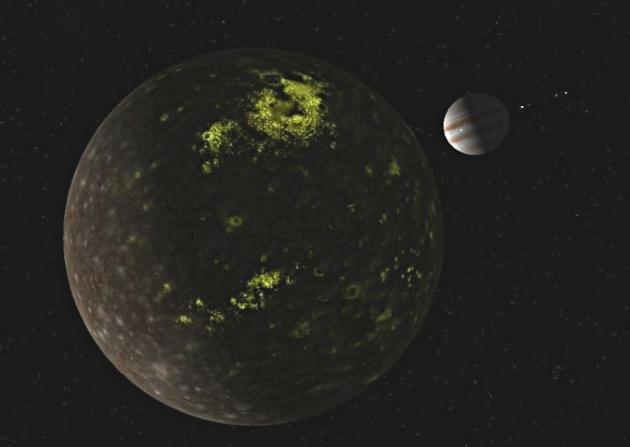 Image from Phil B | |
| Callisto | |
Callisto: Callisto orbit is home to the nominal capital of the Gengineer Republic and the center of gengineering technology in the Jovian system. Provolves, bioconstructs, and biological technology of all kinds are common sights in the subsurface warrens. While Ganymede focuses its gengineering efforts on habitat and biome design, Callisto is much more devoted to biological machines and tools operating within the artificial environments of its sub-surface cities and towns. There are a number of large artificial caverns hosting gengineered biomes, but the overall environment of Callisto is much more urban than that found on its sister world.
Callisto population is only about 60 million, mostly concentrated in sub-surface arcologies and orbiting habitats, particularly the Node 1 habitat housing the governing apparatus of the Gengineer Republic. Node 1 is a large O'Neill type double-cylinder housing 2 million sophonts.
Outer Moons
The remaining Jovian moons have more in common with asteroids than anything else and are largely used as such. Neumann based mining operations extract resources from a number of them and use mass drivers and magsails to ship the results inward to the main population centers. Habitats associated with or built into the various moons range from mining colonies to utopian social experiments (or both). Various low-gravity and micro-gravity adaptations and tweaks are common. Total population for all of the remaining moons is around 12 million.Jupiter Orbital Space
A large number of habitats of various sizes and types orbit around Jupiter and its moons. Built from material imported from the outer moons, the Jupiter Trojan asteroids, and ice launched from the larger moons, the total orbital population of Jupiter is 160 million sophonts. The habitat complexes are home to nearly every type of sophont in existence at the time, with space adapted humans, merpeople, and sapient chimps and bonobos forming nearly a quarter of the population.Jupiter Trojan Asteroids
The Jupiter Trojan asteroids host a number of mining operations supporting the Jovian population as well as habitats and research stations exploring the cutting edge of gengineering. A Jovian experiment in the creation of a cybernetic ecosystem, a "mechology", is underway in a hollowed out asteroid in the leading Trojan asteroid swarm while the trailing swarm sees experiments in the first simple vacuum adapted lifeforms. Total population of both Trojan complexes is a modest 600,000, but that number is expected to climb significantly.The Saturn System | |
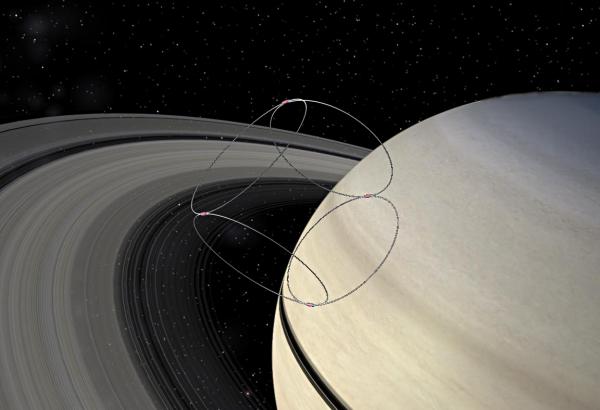 Image from Steve Bowers | |
| A magnetic quadriloop antimatter mining ship in orbit around Saturn | |
Saturn
Saturn's atmosphere is host to around 500,000 floating bubble habitats, each home to around 2000 sophonts (although the largest, most advanced bubble habs may support as many as 10,000 beings). Saturn's lower gravity, longer bubble hab history, and more advanced bubble hab design, combined with a culture that encourages large families, have supported a much higher rate of growth than at Jupiter and the population reflects this. Total planetary population is approximately 1 billion sophonts.Helium-3 extraction stations also operate on Saturn, mainly around the equator. Much like their Jovian counterparts, they launch packaged helium-3 into orbit where tether systems boost it onward to locations both local and interplanetary.
Saturn Orbital Space
Saturn orbital operations extend from low planetary orbit (made possible due to the planet's much weaker magnetic field) outward into the ring systems, which are extensively mined and exploited for everything from volatiles to energy production via tether systems de-orbiting chunks of ice. Many habitats operate within the ring system itself, using the material of the rings for raw materials and fusion fuel. Various environmentalists, mostly based on Earth and in the Inner System, protest this exploitation and warn that eventually the rings will be destroyed by it. Saturnians largely dismiss such notions as silly fear-mongering.In a mixing of mythologies, the ring complex is often referred to as "The Rainbow Bridge" by the locals, mainly due to the way it refracts sunlight passing through it when one is in the ring plane. Total orbital population is around 300 million beings, mostly living in smaller habitats or habitat clusters, some supporting only a single family, clan, or tribe.
Saturnian Moons
Saturn hosts a massive moon system made up of dozens of bodies, most only a few kilometers to a few tens of kilometers across. The numerous smaller moons are mined extensively much like the smaller Jovian moons. Materials are shipped by mass-driver and beamed power driven ion drive systems.Larger Moons
Mimas: The smallest of Saturn's major moons, Mimas is primarily used as a relay point for communications around the Saturn system. While the large amount of ice making up the moon is valuable as a source of volatiles, the lack of heavy elements means that virtually all mining equipment would need to be shipped in. The abundance of volatiles elsewhere in the Saturn system, many in locations also including heavier elements, makes Mimas unattractive for mining at this time.Enceladus: The primary node of the geoflex computing network constructed in the Saturn system. The massive computational power of the node, the waste heat of its operations, and the heavy elements making up a significant fraction of the moon support only a small population of technical support staff, their families, and local data traders who want to be as close to their operations as possible. Although Enceladus could support a much larger population, the Inner System governments and corporations that initiated the geoflex computing project jealously guard their computational super-resource and restrict access to it. As a result, total population of the moon is only about 500,000.
Tethys: Much like Mimas, Tethys is primarily used as a communication relay point and for much the same reasons. The massive volatile stores and relative scarcity of heavy elements make development uncompetitive in comparison to other moons in Saturn space.
Dione: Dione's large quantities of volatiles and heavier elements have led to the founding of numerous colonies and resource extraction operations across the moon. The majority of installations are dug into the ice and the largest have sunk shafts deep beneath the surface to mine heavy elements and tap geothermal power. 80 million sophonts live on and under the surface of the moon, including a number of neo-pig communities. A geoflex computing node within the moon operates as a secondary part of the network dominated by Enceladus.
Much like their counterparts in Jupiter space, the inhabitants of Dione are also master gengineers. Unlike their Jovian cousins, their primary focus is the development of new forms of humanity and other sophonts. The development of the Superior genetic lines is of particular interest to them.
Rhea: Rhea's similarities to Dione have led to the development of a smaller, but still substantial, population of 15 million. Art in all its forms is the focus of a number of enclaves on the moon, including artwork created by or incorporating biological and cybernetic elements or augmentations.
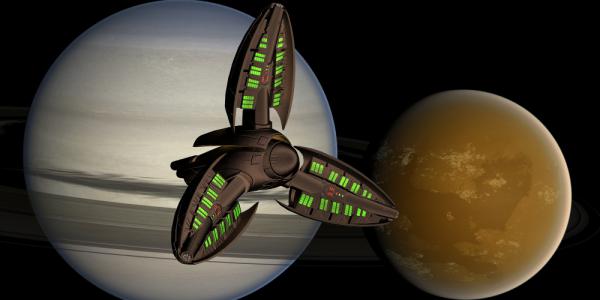 Image from Phil B | |
| Titan | |
Titan: The largest, wealthiest, and most heavily populated moon in the Saturn system, Titan is home to some 400 million sophonts. Much of the surface is dominated by the Cishp culture and the Cishp Bind and its economic ventures. Despite this, several hundred independent communities thrive across the surface and trade with the rest of the Saturn system and the wider solar civilization. Volatiles, hydrocarbons, nanotech products created from the local hydrocarbons, and various other products form the basis of the economy. The Cishp continue to operate their own culture in the deep oceans of the moon. Unknown to most at the time, a geoflex node within the moon provides the Cishp with massive computing power and support for the virtual habitations and simulations used by their elders.
Bioengineering efforts have created a number of simple but hardy lifeforms able to survive on and within Titan's surface and undersea environments. Most of these are designed to process raw materials in various useful ways, but some are purely decorative and are highly prized beyond the Saturn system as living artworks.
Iapetus: The lack of non-volatile materials has left Iapetus largely uninhabited except for automated communication relay stations and deep space monitoring systems.
The Uranus System |
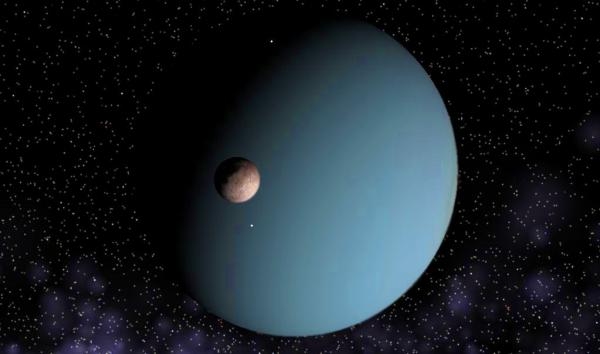 Image from Steve Bowers |
Uranus
Uranus is one of the main sources of deuterium and helium-3 in the solar system. Automated mining platforms float in the upper atmosphere, extract helium-3 and deuterium, package it, and use orbiting skyhooks to launch it off the planet. Once in orbit the helium-3 is collected and sent inward to the rest of the solar system using plasma mag-beam systems powered by space-based fusion reactors burning a fraction of the extracted material. A number of interstellar probes and several crewed ships have launched to the stars using fuel mined from Uranus.A few bubble habs float in the upper atmosphere of Uranus, mostly home to several tweak cultures that seek to adapt themselves to the external planetary environment as much as possible. Total bubble hab population is about 150,000 sophonts although that number is growing steadily. The great distances separating Uranus from the Inner System and even from Jupiter and Saturn have meant that immigration has been rather limited, despite the relatively hospitable conditions in the upper atmosphere.
Uranus Orbital Space
Uranian orbit is home to the various installations that support the atmospheric mining operations, but is otherwise uninhabited in any permanent fashion.Uranian Moons
The major moons of Uranus - Miranda, Ariel, Umbriel, Titania, and Oberon - are all home to small colonies of sophonts. Most are utopian or isolationist communities, although some are home to dedicated scientific outposts performing research in areas that are deemed dangerous, secret, or both. One of the communities on Umbriel is attempting to convert itself into a group mind, while several colonies on Titania are experimenting with the creation of more advanced cyborgs incorporating a larger percentage of nanotech. Researchers on Miranda are working with a consortium of several universities and venture capitalists in the Inner System in an attempt to generate unique forms of a-life to operate as parts of a new generation of self-evolving virtual realities for uploads and AI entities.Total population of the moons is only about 50,000 beings, although the population is growing fast. A major population center is an outpost of the Republique du Tchad, home to fully 2500 people. The primary energy source for all colonies is fusion power.
The Neptune System |
Image from Steve Bowers |
Neptune
Neptune is one of the main sources of deuterium and helium-3 in the solar system, although not as large a source as Uranus. Automated mining platforms float in the upper atmosphere, extract helium-3 and deuterium, package it, and use orbiting skyhooks to launch it off the planet. Once in orbit the helium-3 is collected and sent inward to the rest of the solar system using plasma mag-beam systems powered by space-based fusion reactors burning a fraction of the extracted material. A number of extra-solar and interstellar probes, several crewed expeditions to the Kuiper Belt and Oort Cloud, and two crewed starships have used the Neptunian system as a final staging area before launching using fuel mined from Neptune.Neptune is also home to several bubble hab communities and, perhaps somewhat paradoxically, hosts a somewhat larger population than Uranus, some 250,000 sophonts. The bubble habs of Neptune have taken a somewhat different path from those at Uranus and are pursuing a more inward turned (critics would say solipsist) culture that largely ignores the external planetary environment in favor of extensive and clever enclosed habitats mimicking various terrestrial environments. One thing the Neptunian floater culture shares with its Uranian cousins is very little interest in the cultures and activities of the rest of the solar system. The even greater distance of Neptune from the Inner System, and its less hospitable environment, have kept immigration to a minimum.
Neptune Orbital Space
Neptune orbit is home to the various installations that support the atmospheric mining operations, as well as the habitats and stations used for staging expeditions to the Kuiper Belt and beyond. Raw materials mined from the minor moons of Neptune are used to build the various installations and provide resources on an ongoing basis. Total orbital population fluctuates with the coming and going of expeditions elsewhere, but the permanent population is around 25,000 sophonts.Neptunian Moons
The major moons of Neptune - Triton, Nereid, and Proteus - are all home to small colonies of sophonts. Virtually all are utopian or isolationist communities with little interest in the culture and events of the rest of the solar system. Total population of all the moons is about 10,000, all using fusion power and automated mining to support themselves.The innermost moons of Neptune are home to various automated mining operations, primarily used to support the orbital habitats around the planet. The outermost moons host a few automated navigational beacons and astronomical systems, but are otherwise uninhabited.
The Kuiper Belt |
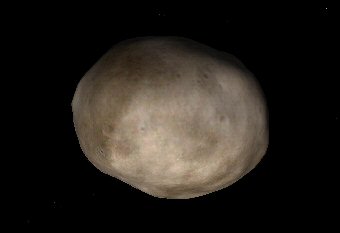 Image from John M. Dollan |
The Kuiper Belt
The Kuiper Belt is home to an eclectic mix of miners shipping volatiles back to the solar system, prospectors and scientists each exploring for their own reasons, and small industries and research groups seeking to use the cryogenic natural environment to make their fortunes. Mixed with these are small groups and a few individuals seeking to build communities or lead lives away from the bulk of Solar civilization. The great distances and long travel and communication times mean that most places are effectively isolated, but a loose, slow common culture is gradually developing, mostly based around a Belt-wide store-and-forward network and a metaphorical return to an earlier era before the advent of instantaneous communication.Total Kuiper Belt population is perhaps 40,000 sophonts, spread across hundreds of communities dispersed across the entire Belt.
The Oort Cloud
The Oort Cloud is the absolute edge of the solar system. A number of probes and automated research stations drift in the outer dark or are attached to various cometary bodies, but widespread development is almost non-existent. Despite this, a few dozen tiny communities have established themselves along the inner edge of the Cloud. Hosting no more than a few hundred people each, they mostly consist of isolationist or utopian populations seeking to develop as far from Solar civilization as possible, often due to an ingrained distrust of various aspects of that civilization such as the increasing numbers of AIs or provolved sophonts, or the increasing use of tweak or splice technology. Other cultures seek to use the vast isolation to explore philosophical or religious thought or new realms of mathematics or other such things.Total population of the entire Oort Cloud is perhaps 50,000 beings.
Related Articles
Appears in Topics
Development Notes
Text by Todd Drashner
Initially published on 31 July 2012.
Minor updates of Near-Earth L4/L5 orbitals added by terranova210486, 2019.
Minor planetary updates by ProxCenBound, The Astronomer, & Todd Drashner, 2022-2023.
Initially published on 31 July 2012.
Minor updates of Near-Earth L4/L5 orbitals added by terranova210486, 2019.
Minor planetary updates by ProxCenBound, The Astronomer, & Todd Drashner, 2022-2023.
